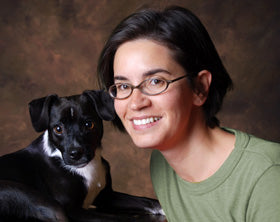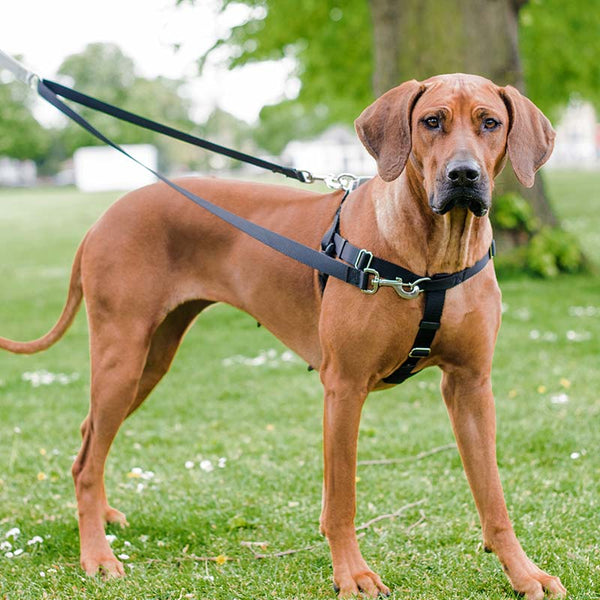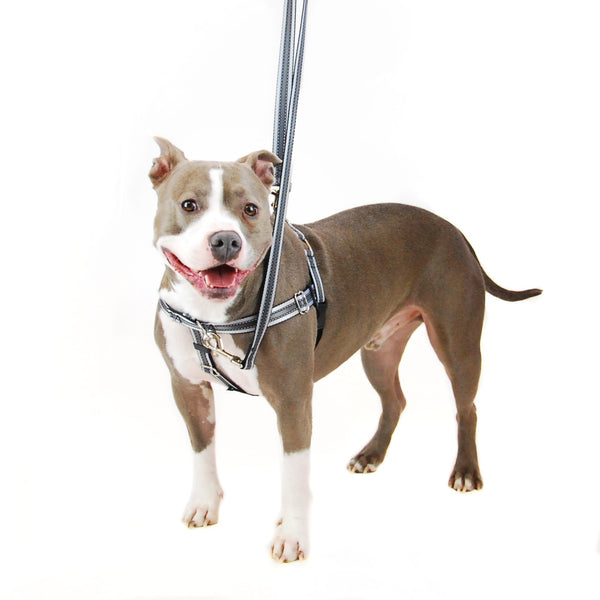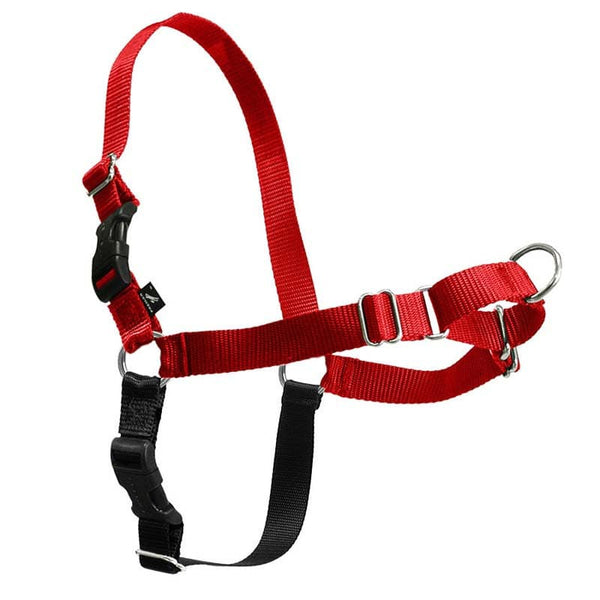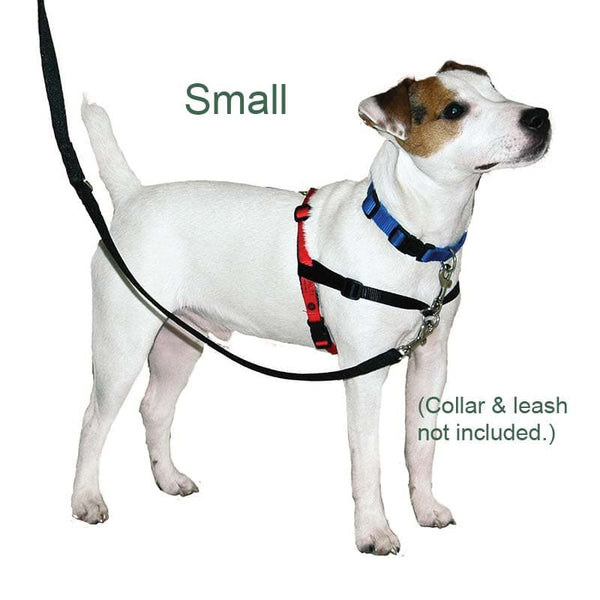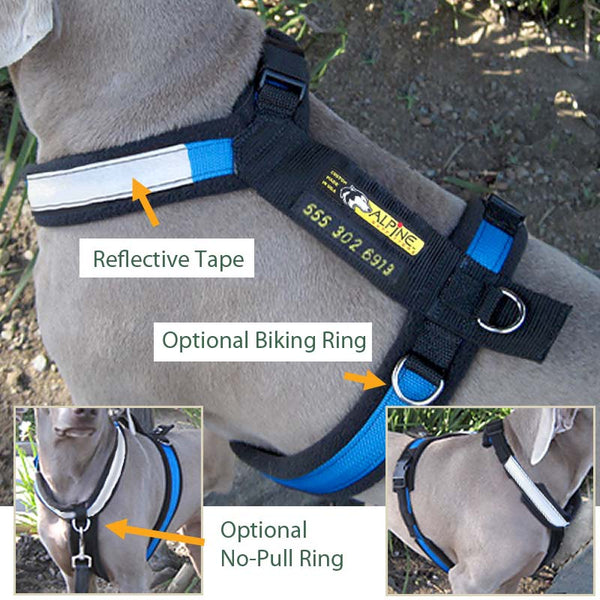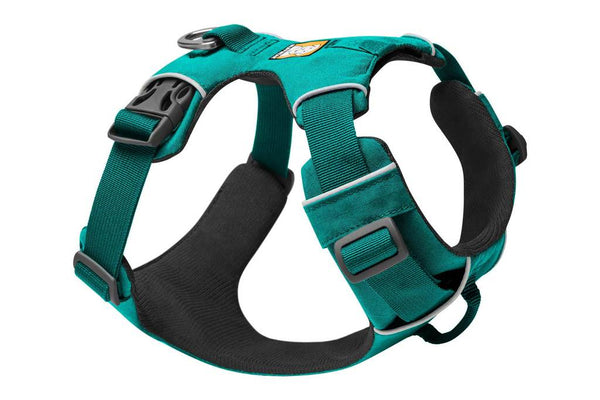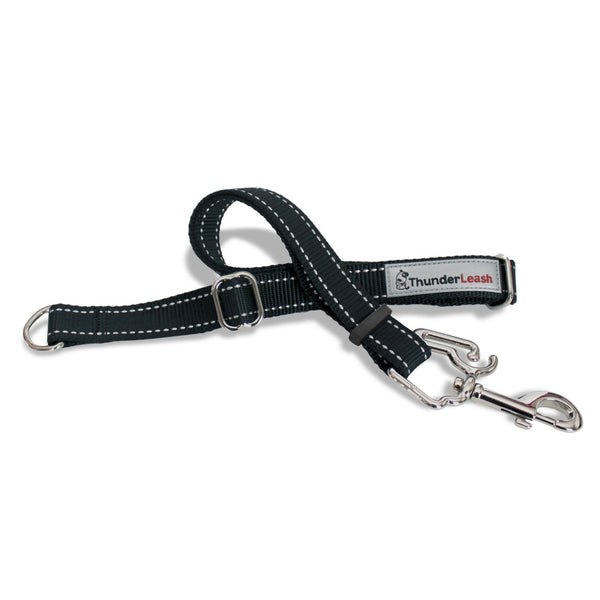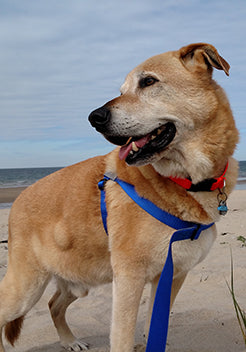Leash Training Your Dog Using a No-Pull Harness

By Jess Rollins
Copyright Info
No Pull front-attachment harnesses are Pet Expertise's biggest sellers and we get numerous rave reviews from our customers. What is so wonderful about these no-pull harnesses for dog lovers is that these training harnesses help your dog learn to stop pulling on the leash while remaining safe and comfortable for him. You will not have to worry about your dog being pinched or choked while wearing a front-attachment, no pull harness and we would argue that it is safer and more comfortable than a regular collar. And no-pull harnesses are easy to use! So, kudos to you for choosing a safe and effective training device for your beloved canine companion. We hope that a few training tips from our professional dog trainer, Jess Rollins, will help you to get the most out of your no pull harness and make your walks more enjoyable, safe and pull-free.
Leash Manners 101: To begin, it's important to spend a few moments ensuring that your dog's no pull harness is fitted properly according to the included instructions as well as tips on our website. You will get the quickest results from your no-pull harness if you begin the training method described below from your very first walk using the harness.
About rewarding your dog: The easiest way to reward your dog is by praising and feeding a high value treat, but we will discuss other reward ideas later on. Do remember to feed less at the next meal to make up for the treats you have given.
Let's go for a walk! Get a few yummy dog treats and a 6 foot leash with a knot about 2 feet from the clasp. Attach the leash to your dog's properly fitted no-pull harness. Helpful hint: For this first walk choose an area to walk in that does not contain too many distractions like other dogs and people and make sure your dog is a bit hungry for your rewards and has recently exercised a bit.
When you begin walking, hold the knot in the leash with the hand closest to your dog and hold the loop across your body in your other hand. Show your dog your treats and say "let's go". If he takes a step with you, reward him for that step and for every step he stays by your side attentively on a loose leash.
As you begin walking with your dog, watch carefully for the moment when he has forgotten about you and is heading for the end of the knotted leash portion. As soon as you see this happening, calmly say "easy". Since he doesn't know what this means yet, he will probably continue to go to the end of the knotted portion of the leash and try to pull, and that is fine for now. The "easy" will have meaning to him in time. As soon as you feel pressure on the knotted portion of the leash, calmly say "oops", let go of the knot, make a U-turn and start walking in the other direction. The no-pull harness will help to communicate to your dog not to pull because when you stop abruptly, his momentum and the no-pull harness will turn him back towards you.
Turning and walking in the other direction not only stops your dog from pulling in that moment, but also gives him another chance to be a "good boy" by walking by your side for at least a moment when he catches up to you. When he is by your side, praise him and feed him a treat and grab up the knot again. Continue rewarding for each step he takes with you. If he passes you and is about to get to the end of the knotted portion of the leash, repeat the above procedure of saying "easy" and then "oops" and turning around. Careful not to get dizzy! By the way, saying the words "easy" and "oops" will help your dog to catch on to this new routine a little faster, but don't worry if you can't remember to say them at first (learning new things is hard, isn't it, your dog thinks so too!). Feel free to substitute different words that come more naturally to you.
Keep repeating the above exercise during your walk. You should start to see your dog staying with you more for your yummy treats (at least when he's not too distracted). Be sure to reward him generously for every step he stays with you at this point. Your generosity will pay off in the next few walks. You should also start to see your dog slowing up or looking at you when you say "easy" or "oops" which is great! Let your dog know that you think he is very smart and handsome!
Especially if your dog is very energetic or has been used to pulling on the leash in the past, it may take some practice to teach your dog to adjust his pace to yours and to build this new habit of walking with you. Don't expect to get too far on your walks in the beginning!
Consistency is very important in teaching your dog to stop pulling on the leash. To ensure success, make sure that your dog never gets to take one step forward into a tight leash while wearing his no-pull harness. If he pulls and gets closer to what he wanted, he will learn that pulling works and our clever dogs will always continue to do what works for them. So, to ensure success, stop walking and turn and go the other way as soon as you feel pressure on the leash.
Quick Summary of Leash Training with a Front-Attachment No-Pull Harness:
- Hold leash at knot. Say "let's go" and start walking.
- Reward your dog when he is by your side for each step.
- If your dog will pull soon say "easy".
- Say "oops" when your dog pulls, let go of the knot, and turn and go in other direction.
- Reward when dog is by your side when he goes by you and for each step he continues with you.
- Continue repeating the above pattern.
"Hooray, He's Pulling Less!" Because no-pull harnesses are such an effective dog training aid, you will start to see improvement in your dog's walking manners immediately or very quickly. Make sure you let your dog know he is doing a good job! When he is walking by your side, praise him and feed him a treat for every single step he takes with you. Once walking by your side gets easy for him, you can start rewarding him for every other step and then every third step and so on. Remember to reward more frequently in more distracting circumstances such as when there is another dog or person nearby.
Sometimes the no-pull harness is so effective that it doesn't seem necessary to do any of these training exercises. However, I would like to encourage you to follow them though since they will prevent your dog from eventually learning to pull into the harness and will also make it easier to train him to walk nicely no matter what type of collar or harness he is wearing.
Practice Makes Perfect! Your dog will be most likely to pull on the leash while wearing his no-pull harness when he is excited. When this happens it is important to make sure you are absolutely consistent about walking in the opposite direction when your dog pulls and to reward more when he is able to walk nicely with you.
Teaching him that he must not pull no matter what will take the longest time to sink in but your dog will learn it much faster if you and others who walk him are consistent and if you also reward loose leash walking generously. For example, let's say your dog wants desperately to say "Hi" to another friendly dog. He pulls. You stop and circle around. He stops pulling and walks two steps with you. You say "good dog!" and let go of the knot and run a few steps over to the other dog as his reward for not pulling. Since we know that he wanted to greet the other dog more than anything in the world and even more than your treats, letting him have what he wants as a reward for his good behavior is most powerful way to reinforce his good behavior. Because we can't always let him have what he wants at that moment, treats are also handy as a way to let him know he did the right thing.
You can generally expect at least some reduction in your dog's pulling by the end of the first walk if your harness is fitted properly. With consistent practice you should see your dog pull less and less. Each dog will require a different amount of time to improve based on how long they have been pulling in the past, their excitability level, how well you can motivate them with your reward, how sensitive they are to the sensation of the harness and of course your consistency in making sure he is not allowed to pull into the no-pull harness.
An excellent exercise to help teach your dog the new rules of no-pull harness walks is to use a distraction you can control. Get ready to walk your dog using the no-pull harness and then toss a small treat about 10 paces ahead of you. Your goal is to allow your dog to get to the object but without pulling! Most likely you will need to do a few U-turns especially at first, but this is a great way to demonstrate to him that he must not pull on the leash.
"My Dog is Still Pulling!" If your dog is not showing any improvement in his walking manners after a few walks, check out our helpful tips:
- Proper Fit: Does the no-pull harness fit properly? Check your instruction booklet and our website to make sure.
- Training Consistency: Are you and everyone else who walks your dog consistent in making sure to stop and go in the other direction the instant the dog starts to pull or even before if you know he is about to pull?
- Motivating Reward: Make sure you have a reward that your dog really wants. You can get him more interested in treats by walking him before a meal or bringing tastier treats such as fresh cheese or meat. If he prefers to have a short ball toss or a bit of tug as a reward, you can do that. What about sniffing breaks as a reward, or a few running steps? Your dog will let you know what he will work for, just experiment! To use a sniff break most effectively, make sure that you don't allow your dog to sniff unless you've said "go sniff". Just keep on walking if he starts to sniff. When your dog is walking nicely by your side say "go sniff" and stop walking and allow him to sniff and potty if he likes. After a minute or so say "let's go" and start walking again.
- Incompatible Behavior: Try rewarding your dog with praise and a treat each time he looks at you while you are walking on the leash. Feed the treat by your thigh even if you have to lure him back towards you. This can work great because a dog cannot be pulling and looking at you!
- Add a Mini Time Out: Do you feel like you are just going around and around in circles and your dog isn't "getting" it? Try adding a mini Time Out after you do your U-Turn. This will help to communicate to your dog that there is someone at the other end of the leash that is important to pay attention to! It goes like this:
- Dog starts to go to end of knotted portion, you say "easy".
- Dog continues to pull into knotted portion, you say "oops", and turn and walk a couple of steps in the other direction.
- Once your dog is on his way towards you stop walking.
- When he is even with you, grab onto the knot in the leash. If your dog stops once he gets to you, wait a few moments and then say "good dog, let's go" and begin walking forward. If he does not stop with you, say "easy" and then when if he continues, say "oops" and turn around and try again.
- Only say "let's go" and continue walking forward when your dog has stopped and waited for you.
Consistency Challenges. It can be inconvenient to change direction every time your dog pulls. While I would like to emphasize that the more consistent you are the quicker your dog will learn to stop pulling, I will also offer you a few tricks to help keep up your consistency in the real world.
If you are in a hurry for a moment during a walk, like crossing a street, and you would like to allow your dog to pull into his harness instead of turning and walking away, you can do one of the following:
- Release the knotted portion before he begins to pull and allow him the full 6 feet of leash. If he has gotten at all used to walking beside you within the 2 feet from the knot, he may just walk within that new larger distance without pulling at all.
- Say "pull!", release the knot and follow him while he pulls into the leash. As soon as you are done allowing him to pull, say "let's go" and resume your routine from above using your "easy", "oops" and turning around.
- Release the knot and run with him so that he doesn't have a chance to pull.
If your dog is being occasionally walked by someone that you know will not follow the "rules" and will allow your dog to pull into the no-pull harness, you may want to preserve your training work and have that walker use a different piece of equipment (like a regular harness or a Head Halters). The Halti No-Pull Harness and Freedom harness is helpful for this since it has a leash attachment at the back or your dog as well as the chest so that you could use the back attachment for "no rules" walks.
If your dog needs more exercise and you do not have a safe way to do so off leash, you may want to use a regular harness (or Halti Harness with leash attached to the back) and a long leash. This way he will get more exercise while you protect the work you have done teaching your dog not to pull into the no-pull harness.
With a little patience and practice, your dog will learn to walk nicely using the no-pull harness! However, if you feel you need more control, or you have a dog who is aggressive or lunges you may want to try one of our Head Halters which will give you more control over your dog's head.
Happy Walks! If you found this article helpful, please consider becoming a customer or sharing it with a friend. Thanks! ~ Jess
View No-Pull Device Comparison Article




